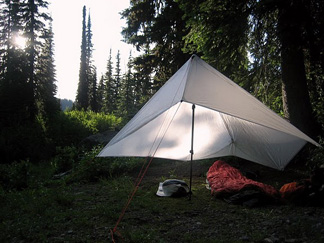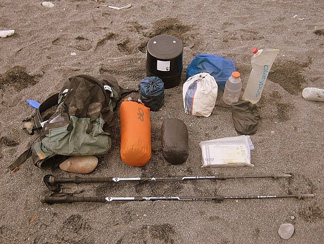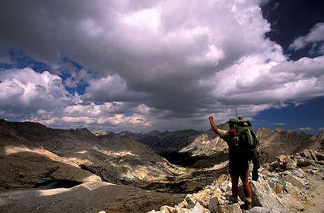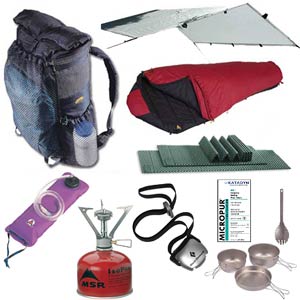
learn
Ultralight Backpacking
Think you've mastered ultralight backpacking? Try comparing yourself to Tom Brown, Jr.
Brown, author and wilderness and expert, has walked naked (!) into New Jersey's wild Pine Barrens and spent days deep in its interior equipped with only 1 item: a knife.
Now that's going ultralight.
Brown is a rarity—an adventurer so resourceful he can confidently vanish into the wilderness carrying just 1 of the Ten Essentials. His story leads any backpacker to wonder: How can I lighten my load without jeopardizing my safety or compromising my comfort?
No single answer applies to every backpacker. Each person has a different idea of what is essential for comfort and convenience. Are you willing to give up that spare pair of socks to save 6 ounces? Such are the tradeoffs an ultralight trekker must repeatedly ponder.
Yet every backpacker probably totes an item or 2 that could be easily ditched or carried in a lighter form. That's the goal of any ultralight makeover: pack smarter to feel lighter, go farther, see more. The rewards, we believe, are worth the effort.
Going Ultralight: The First Steps
 Trimming pack weight can be achieved an item at a time or by building a new system from scratch—maybe a quick-strike setup for weekend trips. The payoff is appealing: more spring in your step, less gravity tugging at you on uphill switchbacks. Here are 2 starter tips for making an ultralight transition:
Trimming pack weight can be achieved an item at a time or by building a new system from scratch—maybe a quick-strike setup for weekend trips. The payoff is appealing: more spring in your step, less gravity tugging at you on uphill switchbacks. Here are 2 starter tips for making an ultralight transition:
1. Compare your usual gear collection with the items outlined on the printer-friendly REI ultralight backpacking checklist. It is an intentionally comprehensive list that you can use to pick and choose items that are most essential to you.
2. If you planning for, say, a 3-day, fair-weather backcountry trip, estimate where your backpack would usually fall on this Pack Weight Continuum:
| |---------------------|---------------------------|---------------------------| | |||
| Minimalist | Ultralight | Lightweight | Plush/Deluxe |
| <12 lbs. | <20 lbs. | <30 lbs. | 30-50+ lbs. |
Near the far right you would bump into my linebacker-size buddy, John, who on every backpacking trip willingly carries (among other luxuries) a 5-pound, 3.5"-thick self-inflating foam mattress. Why? Because John is a big, strong dude who wants his 230-pound frame to feel comfortable at night—and in John's book, that pad is worth the extra weight in his pack.
Most people fall somewhere in between. Your goal: Keep nudging yourself to the lighter end of the spectrum while avoiding drastic compromises to comfort or safety. This article provides ideas for doing just that.
Are You the Ultralight Type?
How light is right for each backpacker on, say, a 3-day solo trip? No official ultralight standard exists, but let's revisit REI's Pack Weight Continuum and go inside the numbers.
| |---------------------|---------------------------|---------------------------| | |||
| Minimalist | Ultralight | Lightweight | Plush/Deluxe |
| <12 lbs. | <20 lbs. | <30 lbs. | 30-50+ lbs. |
Under 12 pounds: Hard-core minimalists take justifiable pride in assembling featherweight loads that fall into the low teens—sometimes even cracking the sub-10-pound barrier. Miniscule loads typically involve customized gear or extreme, edge-of-logic techniques that wow the ultralight faithful but seem like a stretch to the rest of us. Lightweight tarps, for example, make terrific rain shelters. But when bugs are active, more people prefer the full enclosure of a tent, no matter how many extra ounces are involved.
 Around 20 pounds: This is "expert class" territory and can be achieved with relative ease if fair weather is forecast and newer gear is employed (such as a tent with a lightweight 40-denier floor, not traditional 70-denier). Hike with a companion and you can share community gear such as the tent, stove and water filter. Weight savings quickly add up.
Around 20 pounds: This is "expert class" territory and can be achieved with relative ease if fair weather is forecast and newer gear is employed (such as a tent with a lightweight 40-denier floor, not traditional 70-denier). Hike with a companion and you can share community gear such as the tent, stove and water filter. Weight savings quickly add up.
Up to 30 pounds: This weight range is emerging as the new sweet spot for mainstream recreational backpackers—light enough to feel reasonably comfortable on the shoulders, yet stocked with a luxury item or 2 (camp sandals, for instance, or maybe some freeze-dried ice cream.
Over 30 pounds: If you have ample strength, plenty of energy and already own a nice collection of traditional backpacking gear, don't hesitate to use it. For decades it was accepted wisdom that backpackers could carry up to a third of their weight without complication. Years ago on a 12-day hike on the Wonderland Trail around Mt. Rainier, my initial pack weight was 65 pounds—and I had a great time. Admittedly, I'm happier since I've gone lighter. A few years after my Wonderland hike I zoomed a 75-mile section of the Pacific Crest Trail in 3 days while carrying a 24-pound pack. Sweet.
As mentioned previously, you can make a transition to lighter gear an item at a time or go full-bore and create a whole separate ultralight system, perhaps just for shorter trips. A few keys to keep in mind:
- In your drive to lower weight, do not sacrifice safety. For example, don't toss out your first-aid kit or insulation layer just to save a few ounces.
- Realize that ultralight gear is not as brawny as traditional gear and requires some extra care to make it last.
Tom Brown's radical example (walking naked into the wilderness equipped only with a knife) illustrates 2 truths of successful ultralight travel:
1. It is critical that you understand your individual "adventure profile:"
- Skill set—can you improvise if the unexpected occurs?
- Experience level—can you adapt if your plans go awry?
- Comfort requirements—e.g., is any sleeping pad OK or must you go thick?
- Convenience expectations—can you skip a bowl and eat from the pot?
- Safety needs—can you manage with 1 water bottle instead of 2?
2. Based on that self-evaluation, your goal is to carry only the essential gear that meets your personal needs, and do so in the lightest form possible.
Evaluate your traditional "must-have" list. What can be left at home? What can be swapped out for a lighter alternative? Think about items you have carried on past trips and never used. Eventually the ounces you save can add up to real weight.
The Big 4: Pack, Shelter, Bag, Pad
The fastest way to lighten your load? Look at the 4 largest items most backpackers carry: pack, tent, sleeping bag and pad.
Backpack: A 65-liter pack (nearly 4,000 cubic inches) should be plenty for a 3-day, 3-season trip. An ultralight-minded model such as the REI Flash 65 weighs a modest 3  lbs. 2 oz. (When I hiked the Wonderland Trail around Rainier many years ago, I used an expedition-size backpack that weighed 8 pounds empty. Wow.) Savvy ultralight devotees manage with even smaller packs, in the 40- to 50-liter range, occasionally even smaller. Keep in mind that lighter packs use lighter materials and are not as durable as traditional packs.
lbs. 2 oz. (When I hiked the Wonderland Trail around Rainier many years ago, I used an expedition-size backpack that weighed 8 pounds empty. Wow.) Savvy ultralight devotees manage with even smaller packs, in the 40- to 50-liter range, occasionally even smaller. Keep in mind that lighter packs use lighter materials and are not as durable as traditional packs.
Tent: Hard-core ultralight backpackers typically use only tarps as rain shields; they simply deal with bugs.Another option: bivy sacks. They provide low weight and full enclosure, but no sit-up space. That's not an issue for some people, but it’s maddening for others.
Sleeping bag: The right bag for the right person in the right conditions means a backpacker saves on both weight and bulk. It's easy to understand how an ultralight mindset becomes addictive: If I can save a pound on my bag, and 2 pounds on my tent, how low can I go?
Sleeping pad: Self-inflating foam pads have been traditional backpacking favorites for decades. If you don't mind applying your lungs to your pad, check out the low-weight air pad options such as the NeoAir series from Cascade Designs, Big Agnes’ Air Core pads and Exped pads. You get a lot of cushioning for not much weight as long as you don't mind some huffing and puffing.
 More Ultralight Choices
More Ultralight Choices
As you work through the REI ultralight backpacking checklist it will become apparent that going UL involves item-by-item choices where you must weigh tradeoffs against benefits and finally make a decision. Initially, not every one may be right, and experience may lead you to modify your choices for future trips. Here's a look at a few commonly carried items and how different backpackers might select them:
| Gear | Minimalist | Ultralight | Lightweight |
| Footwear | Running shoes | Light hikers | Hiking boots |
| Trekking poles | Carbon fiber poles | Carbon fiber poles | Standard poles |
| Tent stakes | No stakes; rocks | Just 4-6 stakes | Most or all stakes |
| Stove | Fuel tabs, soda can | Tabs or canister stove | Lightweight stove |
| Cookpot | Titanium mug | Titanium mug or pot | Lightweight cookset |
| Utensil | Spork | Spork | Plastic utensils |
| Water filter | Halogen tablets | Tablets or filter | Filter |
| Water bottle | Soft bladders | Bladders or bottles | Bottles |
Again, every item carried is a matter of choice, where you must balance your desire for convenience and in-camp comfort with your preference for low pack weight.
Can you get by with a small knife or multitool? Can you skip that camp pillow and instead wad up your jacket and prop that under your head at night? Is your load light enough to allow you to switch from boots to low-cut footwear?
But be careful not to compromise safety by tossing out essentials. Just because your watch includes an electric compass does not mean you can leave behind your magnetic compass. The watch could break or the batteries die. A good first-aid kit will include more than a few bandages. Don't go overboard in trimming weight from your kit. A whistle? True, you may never use it, but if you slip and need to signal help from an off-trail location, you want to have one handy.
When John Muir stepped into the Yosemite backcountry, biographer Amy Marquis noted he traveled alone, carrying "only a tin cup, a handful of tea, a loaf of bread, and a copy of Emerson." If you can keep your pack load that small, feel free to take along a favorite book. You deserve such a luxury.
Courtesy of REI

